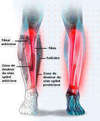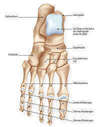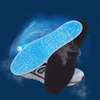Are you experiencing pain in your shin? Does it intensify when you press it? Does it hurt when you walk or run? All of these symptoms may indicate that you have periostitis.
Definition of periostitis
Runners are the most concerned by periostitis, which refers to a suffering of the periosteum.
The periosteum is the outermost part of the bone. This outer layer can become inflamed when it is overstressed. This is what causes periostitis to develop. Increasingly, we are talking about periostitis, which is a remodeling of this bone layer. At the beginning, it starts with inflammation, so we speak of "periostitis" but once installed a reshuffling of the bone frame was highlighted and we speak of "periostosis".
Pain: a warning sign!

Pain in the shin is the main symptom to consider. It often occurs on the inside of the shin. It is not a localized pain in one place but extends over the whole bone or part of it. You will notice this when you press around the area where the pain has occurred.
Generally speaking, pain only occurs when you run. However, it can also prevent you from walking when the periostitis is in an advanced stage.
Is it necessary to carry out additional examinations?
It is not possible to detect periostitis by taking an x-ray even though it is the outer membrane that covers the bone. However, it can be detected with a bone scan. This test is not necessary, however, as the specialist only needs to feel the leg to make a reliable diagnosis.
The different causes of periostitis
You may be wondering how you got periostitis after running for many years. There are several reasons why you may have developed periostitis and why the pain may have appeared. It can become disabling, especially for amateur and professional athletes.
Running on a ground that is too hard or too soft
Your body feels an impact of up to 8 times your weight when you run. On average, you receive more than 800 impacts when you run a distance of 1 km.
If you run on hard ground, it tends to increase the vibrations perceived by your body. However, soft ground can also lead to periostitis because the anterior tibial muscle exerts a lot of traction on the periosteum.

Having the wrong shoes for your activity or your feet

There are many shoes to choose from that will fit your feet. You also have the option of choosing shoes that are appropriate for the type of terrain you are running on. They should be different when you run on asphalt or on a dirt road.
In addition, your shoes must be adapted to your stride type. It will therefore be necessary to pay attention to the size of the drop of your shoe, that is to say the difference in height between the front and the back of the shoe.
Ask a podiatrist, the foot specialist, for advice when you want to buy a new pair of shoes, or your osteopath, provided he or she is trained to do so. He or she will help you choose the model that is best suited to your feet and your stride.
Poor running technique
We are not taught to walk and even less to run. We run as we can, nevertheless some strides are more deleterious than others and this is the case of the heel strike stride. Most people run the same way they walk, i.e. they put the heel first and then the step afterwards instead of putting the middle or the front of the foot on the ground. The fact of heeling limits the shock absorption and the tibia gets tired of absorbing the traumas, hence the periosteum. The solution is to change your stride, but this can take 2-3 years. The quicker solution is to wear a pair of shoes that forces you to put your foot in the middle or in front and that prevents you from heeling.
Having poor hydration or nutrition
A good hydration is essential for our survival since our body is composed of 60% of water. A lack of hydration makes our body suffer and this can result in periostitis.
Moreover, an acidic diet is also a factor in the aggravation of periostitis. It is therefore recommended to favour an alkaline / basic diet.

Too much intense training
This phenomenon mainly concerns those who have stopped doing sports and who wish to resume a sporting activity with the same intensity. However, it is preferable to start again gently and to increase the efforts made little by little. Otherwise, it can cause different pathologies such as the windshield wiper syndrome or periostitis. The former refers to pain localized to the TFL or Fascia Lata Tensor. As soon as these pains appear, you are forced to stop all sports activities.
You need to adopt the right strategy. It's about exercising regularly while gradually increasing the intensity. This gives your body time to adapt to the changes and prepare for any trauma it may experience.
Having joint blockages

Be aware of blockage at different joints. It can occur in the fibula, tibia or foot. This problem also affects the surrounding structures, which can lead to traction of the muscles near the periosteum.
What are the remedies?
While strong mental strength can help an individual heal, it is not enough in the case of periostitis. One of the following twelve solutions must be adopted to regain good health.
1. Resting
Athletes don't like to be inactive. However, resting allows the necessary measures to be taken as soon as possible when the problem occurs. This technique avoids the permanent cessation of a sporting activity. In some cases, it is recommended to rest for at least 2 weeks, but your practitioner will be able to advise you on the necessary downtime.

2. Analyze your stride
This step takes place on the running field or on a carpet. It allows the specialist to observe and analyze your stride. This allows him to better understand the causes of your pain.

3. Ensure the quality of the shoes and replace them if necessary

4. Perform a massage on the area
While massaging the shin when you have periostitis is a great way to get rid of the inflammation quickly. While some people prefer to use the rolling pin method, others use their phalanges primarily to apply deep pressure.

5. Apply ice cubes to the part of the
To reduce inflammation, take ice cubes and place them on the painful area for 15 minutes. Do this 1 to 3 times a day depending on the intensity of the pain, especially after a massage. Remember to ice especially after physical activity.

6. Stay hydrated

We never say it enough, water is essential for the proper functioning of your body. Drink 1.5L of water per day and even more when you do sports!
7. Eat properly

8. Use Kinesio taping
These bands aim to optimize lymphatic drainage. The tensions they create lift the skin and thus optimize lymphatic drainage.

9. Use poultices

Green clay is known for its anti-inflammatory properties. You must then put them in a thick layer on the painful area. Then wrap with cellophane so that the poultice does not dry. Remove after 3 hours.

You can also use essential oils such as wintergreen or arnica. However, you should seek advice on the correct dosage and method of application.
10. Use a compression sleeve

Within the framework of a periostitis, the sleeve has for role to compress the calves and thus to avoid the ballooning and the traction of the muscles on the periosteum. It also aims to improve lymphatic and venous drainage and thus flush out toxins.
11. Physiotherapy
The physiotherapist uses massage techniques to help drain the inflammation. Multiple sessions are recommended if the periostitis has been present for a long time. Your physiotherapist can also strengthen the muscles around your foot to stabilize it as much as possible and improve your running technique.
12. Osteopathy

The osteopath is able to manage a patient suffering from periostitis. He will examine you from head to toe to determine the origin of your periostitis. He can detect any blockages in the ankle, foot, knee or higher. In addition to checking the bone, he will also examine the muscles and ligaments. He will then treat the cause but also the imbalances that this may have caused on your body. He will also be able to advise the right treatment, shoes, etc., especially if you have continued to run despite the pain.
